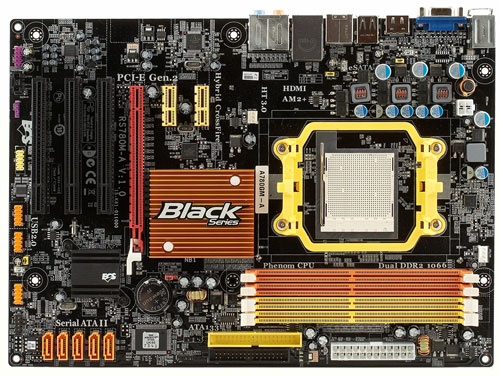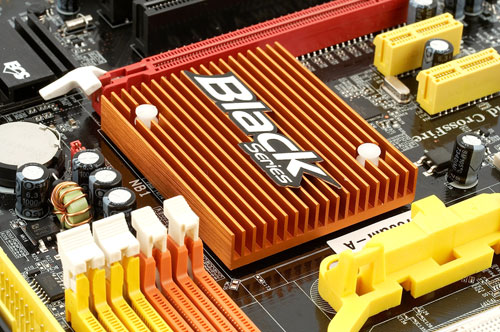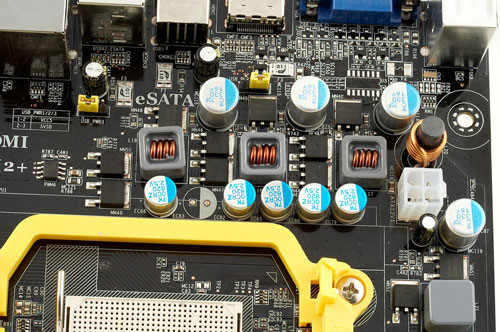ECS A780GM-A Motherboard on the AMD 780G Chipset (Socket AM2+)
|
- AMD 780G chipset (AMD 780G Northbridge and SB700 Southbridge)
As the first product with integrated graphics launched by AMD a year ago, the 690G chipset was a success. The industry supported it. Strictly speaking, it looks competitive even now, if we agree with AMD and compare it with the equally priced CPU/motherboard with integrated graphics (G33/G35) from Intel instead of the NVIDIA product for the AMD platform. However, users will agree to this comparison, only if the advantage of the AMD kit is apparent and will remain (or improve) in time. Only on this condition the difference will be noted and taken into account. System integrators will do it in the first place, because typical users of integrated graphics solutions are far from complex calculations of prices and performance.
That's why the 780G chipset is no less important for AMD than updates in CPU product lines. AMD has to compete on the internal market as well (with NVIDIA chipsets). Besides, engineers from former ATI must prove that they can control the situation. AMD did everything right: the company launched the new product and proved its worth. Indeed, it's unsportsmanlike to compare with the G35. But we'll publish this comparison in the traditional chipset review (it will also touch upon other peculiarities of the AMD 780G, Hybrid CrossFire in the first place, and test HD Video decoding using UVD—we just had no time to include this information into this article). The NVIDIA chipset is not defeated, but the company will have to compete with AMD by dropping prices, in order to retain its share of the AMD market.
However, the first motherboard on AMD 780G to be tested in our testlab is not intended for typical users of motherboards with integrated graphics. It's a full-size ATX motherboard, which reminds of such popular products as the Gigabyte M55plus-S3G, Gigabyte MA69G-S3, and MSI K9AG Neo2-Digital. This motherboard (black PCB instead of lilac) starts a new Black Series from ECS, which will comprise motherboards for fastidious but thrifty users, that is those who want to get a functional and upgradeable basis for an all-purpose computer. The above-mentioned motherboards proved their worth for such users: will the ECS A780GM-A become just as popular?
 Note a long low-profile heat sink on the Northbridge. Engineers decided to use the remaining room behind unpopular PCIEx1 slots for chipset cooling. However, the full-sized PCB allowed to install three PCI slots as well. IDE, FDD, and both power connectors are placed in the most convenient places of all possible locations. Clear CMOS jumper is accessible, when the motherboard is installed into a PC case with any set of expansion cards.
 Our tests demonstrate that temperature of the heat sink on the Northbridge does not depend much on GPU load (even in overclocked mode). In fact, temperature of the chipset heat sink depends more on the cooling of the CPU and graphics card. In other words, a hot graphics card and a CPU with an inefficient cooler may heat the motherboard and the heat sink on its chipset much more than the Northbridge, which dissipates 11.4W maximum (Southbridge adds less than a single Watt to the total heat release of the chipset). We tested the motherboard in this very mode (Radeon 1900XTX, the boxed cooler on the Athlon 64 X2 4000+ is installed with the fins perpendicular to the fins on the chipset heat sink to eliminate its participation in indirect cooling, Smart Fan is used to adjust fan speed to keep CPU temperature at 60B°C), but we failed to overheat the chipset. If a graphics card is not installed, and a processor is cooled to typical 40-45B°C, the chipset heat sink remains barely warm even under maximum load, and the system temperature does not exceed temperature of the air inside a PC case by more than 5B°C. To all appearances, AMD won't have to change much in a mobile version of this chipset.
 There are no empty seats on the board, because it's the only model from ECS on this chipset. The 4-phase switching voltage regulator of the processor incorporates three field-effect transistors per channel, seven 820 uF capacitors and four 330 uF ones. They are all solid-state capacitors from Cheng Tung (however, this company has been manufacturing capacitors for ten years already, and it has never been mentioned in notorious scandals about "leaks" besides, modern solid-state capacitors cannot leak at all). It's good of such an inexpensive motherboard to have a 4-phase voltage regulator instead of a 3-phase one. It's more efficient, so it does not heat that much and raises stability of the output voltage. Such regulators seem to become a pleasant feature of motherboards for Socket AM2+. Motherboard dimensions—305x220 mm (narrow ATX, six-screw mount, the right edge of the motherboard is loose. System monitoring (ITE IT8726F-S, according to BIOS Setup):
- CPU and memory voltages
- Rotational speed of CPU and system fans
- CPU and board temperatures (by the corresponding embedded sensors)
- Smart Fan, automatic control of a CPU fan; you can specify a temperature threshold, when the system starts adjusting fan speed, and a temperature, when the fan accelerates to its full speed. Fan speed between these values grows according to the Fan Slope value (how much fan speed grows per each degree). Only 4-pin fans can be controlled.
Onboard ports, sockets, and connectors
- Processor socket (Socket AM2, compatible with AM2+, officially supports all AMD Phenom and Athlon 64/X2/FX/Sempron processors for this socket)
- 4 x DDR2 SDRAM DIMM (up to 8 GB of DDR2-400/533/667/800/1066, dual-channel mode)
- 1 x PCIEx16 2.0
- 2 x PCIEx1 2.0
- 3 x PCI
- Power connectors: standard ATX 2.2 (24 pins, you can use a usual 20-pin connector), a 4-pin ATX12V connector for a processor
- IDE (Parallel ATA) for two ATA133 devices—"chipset-based"
- 5 x SATA II (Serial ATA II) for five SATA300 devices, chipset-based, connected drives can form RAID 0, 1, and 0+1
- 3 connectors for rear panel brackets with 6 x USB
- 1 x CD/DVD audio connector
- Connectors for analog audio ins and outs on the front panel
- Connector for a bracket with S/PDIF-Out
- Connector for a bracket with a COM port
- Two fan headers, CPU fan speed can be controlled manually and automatically in BIOS.
Back panel (left to right, blockwise)
 Click the image for the rear view. Click the image for the rear view.
- PS/2 mouse and keyboard
- VGA
- HDMI
- 2 x USB
- eSATA300 and 2 x USB
- 2 x USB and 1 x RJ-45 (Gigabit Ethernet)
- 6 x Analog Audio (Center/Sub, Side-Out, Rear-Out, Line-In, Front-Out, Mic-In).
Package Contents
- Package: a small box of an original design for the new Black Series of motherboards from ECS. It will include products on medium-price chipsets (unlike the Extreme Series) for common users. However, owing to the full-size design and rich peripheral interfaces, such motherboards will please so-called moderate enthusiasts, fastidious but thrifty
- Documentation: User's Manual and a poster in many languages with installation instructions
- Cables: 2 x SATA (with latches), 1 x ATA66
- Rear I/O shield
- CD with drivers and Adobe Acrobat Reader.
This bundle does not include a proprietary utility for updating BIOS and system drivers, which can also search for the latest versions on the manufacturer's web site. However, all BIOS packages on the web site include the standard AMI utility to flash BIOS in Windows. The HDMI-to-DVI adapter may come with the product, but you should make sure it does, when you buy the motherboard (if you need it). Integrated Controllers
- Audio, based on the chipset support for HD Audio and IDT 92HD206 codec, 7.1 channel audio, front line-ins/outs, S/PDIF-Out, and CD-In
- Gigabit Ethernet 10/100/1000 Mbps based on PCIE controller Atheros Attansic L1.
The integrated audio quality was tested in 16 bit 44 kHz mode using RightMark Audio Analyzer 6.0.5 and the ESI Juli@ sound card:
| Frequency
response (from 40 Hz to 15 kHz), dB: |
+0.54, -12.08
|
Very bad
|
| Noise level,
dB (A): |
-90.0
|
Good
|
| Dynamic range,
dB (A): |
89.1
|
Good
|
| THD, %: |
0.0057
|
Very good
|
| THD + Noise,
%: |
-78.6
|
Average
|
| Intermodulation
distortion + Noise, %: |
0.023
|
Good
|
| Channel crosstalk,
dB: |
-92.7
|
Excellent
|
| IMD at 10
kHz, %: |
0.012
|
Very good
|
General performance: Good. ECS engineers sometimes try to find a replacement for Realtek chips. Most users are indifferent to such tries, if we speak of network adapters. But in case of integrated audio, there are noticeable differences between them. As we have already mentioned in our review of the ECS NFORCE6M-A (where we've seen the IDT controller for the first time), it's generally similar to Realtek ALC883, except for radically cropped low frequencies. Hence the low mark in the first test. Such codecs may be installed on motherboards that will be used only with cheap speakers built into monitors. The target audience of this motherboard may be displeased with this choice (except for those who will install a sound card.) Settings
| Jumpers and switches |
Clear CMOS jumper |
|
| USB-PWR R jumper |
Wake on USB for the ports installed
on the rear panel |
| USB-PWR F jumper |
Wake on USB for the ports installed
on brackets |
| AMI BIOS 2.61 |
Allows to disable specific CPU functions |
+ |
Virtualization
Cool'n'Quiet |
| Memory timings |
+ |
Ganged/Unganged Mode, CAS Latency, RAS to
CAS Delay, Row Precharge Time, Min RAS Active Time, Row Cycle
Time |
| Memory frequency selection |
+ |
Auto, 200, 266, 333, 400, 533 MHz (the effective
frequency is twice as high, you actually specify a multiplier
to the FSB frequency) |
| HT bus setup |
+ |
Auto, 200, 400, 600, 800, 1000, 1200, 1400,
1600, 1800, 2000, 2200, 2400, 2600 MHz (you actually specify a
multiplier to the FSB frequency) |
| PCI IRQ manual assignment |
- |
|
| FSB frequency setup |
+ |
200-500 MHz at 1 MHz steps |
| CPU multiplier |
- |
|
| CPU voltage control |
+ |
+0.004-+0.252 V at 0.004 V steps |
| Memory voltage control |
+ |
+0.01-+0.63 V at 0.01 V steps |
We used BIOS dated 21.01.2008, the latest release version. The mentioned BIOS parameters are available in this version, but the viability of non-standard settings hasn't been tested.
BIOS offers all main options for moderate overclocking, it allows to raise CPU and memory voltages. The chipset is officially supported by AMD OverDrive. However, AMD OverDrive 2.0.14 beta could control only several parameters (including the CPU multiplier, which is not available in BIOS) instead of a multitude of frequencies and voltages as in case of AMD 790 chipsets. It's hard to tell so far whether it's a problem of this motherboard (or the first BIOS version) or the existing version of the utility, or of the entire family of motherboards on this chipset.
Overclocking
In order to evaluate motherboard and its BIOS, we overclock our testbed processor to a maximum stable level. We use all features of the motherboard in this test, including raising CPU voltage and adjusting multipliers and frequencies of system and peripheral buses, if necessary (but if, for example, reducing Hyper-Transport frequency does not improve overclocking, we leave the default multiplier). Memory is set to the standard frequency for a given memory module (multiplier correction), if a manufacturer does not publish any ways to improve memory overclocking. Otherwise, we analyze their efficiency as well. In order to evaluate stability of the overclocked system, we load Windows XP and run WinRAR performance test for 10 minutes (Tools—CSBenchmark and hardware test). As overclocking potential is an individual property of a given motherboard sample to some degree, we don't set the task to determine overclocking potential to within a single MHz. In practice, we are to find out whether CPU overclocking will be limited by a motherboard as well as to evaluate its behavior in non-standard modes, including automatic restoration of a correct frequency after a failed overclocking attempt, etc.
| |
Clock, MHz |
FSB Clock, MHz |
Core voltage (according to system monitoring
in BIOS), V |
HT bus frequency (multiplier), MHz |
| Athlon 64 X2 4000+ (2.0 GHz) |
2400
|
240
|
1.40
|
1200 (x5)
|
Overclocking results are not very impressive. However, we didn't raise the Northbridge voltage. And in this case it's the graphics core in the chipset that limits overclocking. With a graphics card, we managed to overclock the motherboard by 270 MHz. We broke no records, but these results are sufficient for revealing potential of most processors.
Performance
Testbed configuration:
- CPU: AMD Athlon 64 X2 4000+
- Memory: 2 x 1 GB Kingston KHX7200D2K2/1G (DDR2-800)
- HDD: Seagate Barracuda 7200.10 (SATA, 7200 rpm)
- Graphics card: ATI Radeon X1900XTX, 512 MB GDDR3
- PSU: Chieftec CFT-560-A12C
- OS: Windows XP SP2
We'll compare our product under review with the recently launched NVIDIA GeForce 8200 chipset (we are currently testing the Palit N78S motherboard on this chipset) and the AMD 690G, represented by the MSI K9AG Neo2-Digital, which has a similar market positioning.
| Test |
integrated graphics |
discrete graphics |
| MSI K9AG N2-D |
Palit N78S |
ECS A780GM-A |
MSI K9AG N2-D |
Palit N78S |
ECS A780GM-A |
| Archiving with 7-Zip, min:sec |
6:29 |
6:31 |
6:55 |
6:28 |
6:28 |
6:43 |
| MPEG4 (XviD) encoding, min:sec |
6:00 |
6:05 |
6:11 |
6:00 |
6:00 |
6:06 |
| Unreal Tournament 2004 (Medium@800x600),
fps |
29.7 |
46.4 |
46.5 |
57.3 |
57.5 |
56.2 |
| Unreal Tournament 2004 (High@1024x768),
fps |
25.5 |
35.8 |
37.5 |
57.6 |
57.4 |
56.4 |
| Unreal Tournament 2004 (Highest@1600x1200),
fps |
10.5 |
17.4 |
17.7 |
57.0 |
57.6 |
55.8 |
| FarCry (Medium@800x600), fps |
36.9 |
64.1 |
69.1 |
123.2 |
131.3 |
125.0 |
| FarCry (High@1024x768), fps |
30.8 |
42.5 |
47.4 |
122.8 |
132.5 |
127.1 |
| FarCry (Highest@1600x1200), fps |
13.0 |
20.2 |
21.2 |
121.5 |
130.2 |
125.3 |
| DOOM III (Medium@800x600), fps |
15.1 |
41.5 |
42.1 |
137.3 |
139.3 |
133.6 |
| DOOM III (High@1024x768), fps |
12.4 |
27.3 |
29.2 |
137.3 |
137.9 |
133.1 |
| DOOM III (Highest@1600x1200), fps |
4.6 |
12.6 |
13.7 |
109.1 |
109.8 |
107.7 |
The AMD 780G outperforms the GeForce 8200 a little in the tests with integrated graphics. Compared to the AMD 690G, the result resembles a situation with GeForce 8200 vs. GeForce 7050. In other words, AMD managed to double the graphics core power since the previous generation and add DirectX 10 support. What concerns the performance-per-Watt ratio, the AMD solution also outperforms the NVIDIA product, TDP=12 W versus 14.3 W in high performance mode. Thus, if you want to raise performance, you may overclock the graphics core and still use passive cooling. Some manufacturers may do it on their own.
In this article we have tested the most unassuming solution—standard frequencies, system memory is used as a video buffer. However, AMD 780G can be equipped with dedicated DDR2/GDDR3 memory, such products already exist. So these are only intermediate chipset results. We'll proceed with our tests, because this chipset is definitely worth it.
What concerns the ECS motherboard, we can formally complain about non-optimal settings of the memory controller. Even though we specified memory frequency and timings manually, results in the most sensitive arithmetic tests are far from brilliant. But it will hardly be noticeable in real programs and especially in applications that depend on a graphics core.
Conclusions
The more attractive chipsets with integrated graphics become, the more popular full-size motherboards on this chipset get. There is nothing surprising about it. Such motherboards usually come at democratic prices, and their functionality may often please even hard-driving users. You may even assemble a powerful all-purpose computer, not just a typing machine for an office. Only Gigabyte and MSI offered full-sized motherboards on AMD 690G. So we can understand why ECS wants to enter this segment with its Black Series for fastidious and thrifty users. There are objective prerequisites for it: excellent chipset, good implementation, they just have to pay more attention to BIOS. What concerns prices, even the first retail offers demonstrate an aggressive pricing policy.
Motherboard provided by the manufacturer.
Dmitry Laptev (lpt@ixbt.com)
March 24, 2008
Write a comment below. No registration needed!
|
|
 |
|
|
|



